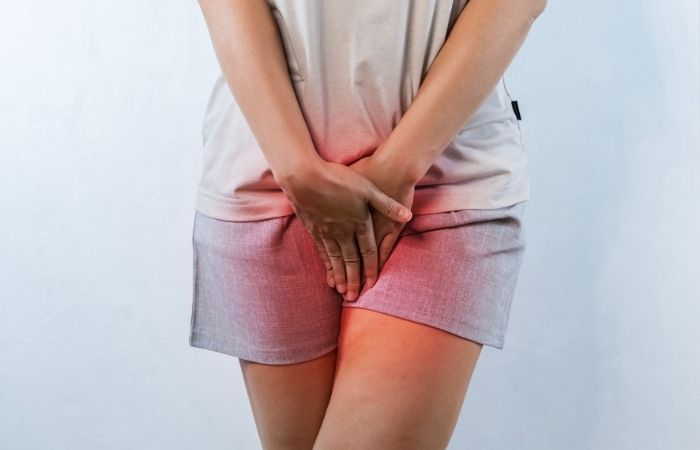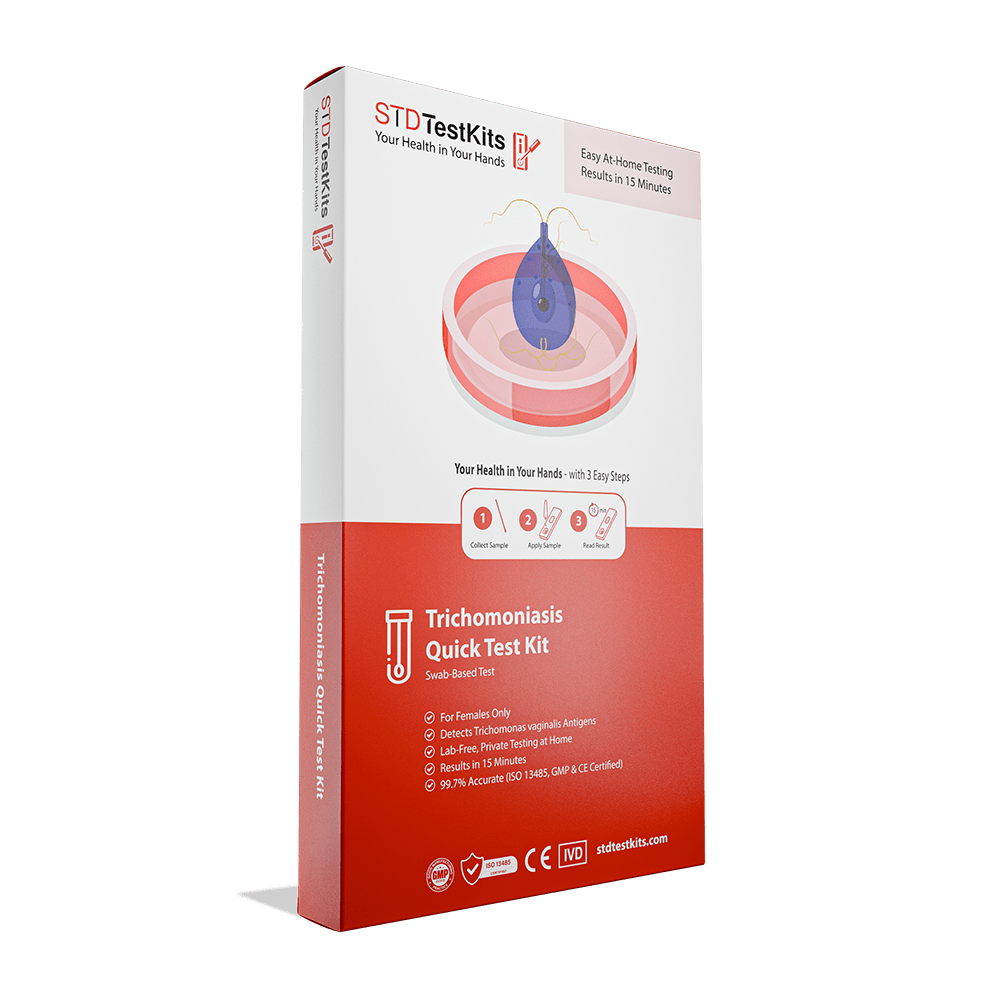When Is It Too Soon (or Too Late) to Test for Chlamydia?
Quick Answer: The best time to test for trichomoniasis is 7 to 14 days after exposure. Testing earlier is possible, but you may need to retest. Unlike yeast infections, trich often causes frothy, greenish discharge and odor. If yeast treatments haven’t helped, it’s time to check for STDs.
Why This Guide Matters: One Misdiagnosis Can Spiral
Maya, 27, had been through three yeast infections in a year, or so she thought.
“It was always the same: itching, irritation, and some discharge. But Monistat would barely help,” she said. “Finally, my gyno ran a full panel. Turned out it was trichomoniasis the whole time.”
Stories like Maya’s aren’t rare. Trichomoniasis is one of the most common, but most overlooked, STDs. It’s especially common in people with vaginas and often shows up with mild or confusing symptoms that mimic yeast, BV, or just irritation. And because you can buy yeast meds over the counter, many people try to treat themselves without knowing an STD is lurking underneath.
This guide is for you if:
- Your yeast infection symptoms keep coming back after antifungals
- You have burning, itching, or discharge but tested negative for yeast
- You recently had unprotected sex and symptoms showed up days later
- You’re scared, overwhelmed, or unsure where to start
Let’s break it all down, without judgment, just answers.

People are also reading: Think You Have HIV? Why Testing Too Early Can Backfire
Trich vs Yeast: Symptom Showdown
Yeast infections and trichomoniasis can feel eerily similar at first, but there are key differences once you look closely. Here’s what patients and clinicians often use to tell them apart.
Figure 1. Key symptom differences between yeast infections and trichomoniasis. Always test to confirm, visuals alone can be misleading.
Still confused? You’re not alone. A CDC-backed study found that up to 70% of people with trich have no symptoms, or mistake them for something else.
When Does Trichomoniasis Show Up After Sex?
Let’s talk timing, because this is where most people go wrong. The “window period” is the time between exposure to an STD and when a test can reliably detect it. Testing too early? You might get a false negative. Testing too late? You might have already passed it to someone else.
Figure 2. Only STDs have window periods. Yeast infections aren’t STDs, but trich is, and that timing matters.
If you’ve had unprotected sex or a new partner in the last month and started having symptoms, the safest move is to test for trich between 7 and 14 days post-exposure. Earlier testing is possible, but a negative might not be reliable. If symptoms persist, retesting at the 14-day mark helps confirm results.
Still not sure? The STD Test Kits homepage has discreet options you can order from home, including a combo test that screens for trich along with other common STDs.
What Real Exposure Looks Like (And Why It Gets Missed)
Jasmine, 31, wasn’t worried after a one-night stand.
“We used a condom,” she said, “but a week later I started feeling itchy and weird. I figured it was a yeast infection.”
She tried Monistat. Then Diflucan. But nothing worked. “By the time I tested, it had been 19 days. It was trichomoniasis all along.”
Most people think trich only happens in obvious high-risk encounters, like unprotected sex with a new partner. But exposure scenarios aren’t always that simple. Here’s where trichomoniasis hides in plain sight:
- Condom broke, but no ejaculation? Still a risk. Trich spreads through skin-to-skin contact and pre-ejaculate.
- Only received oral sex? Uncommon, but not zero risk. Genital-to-genital is far more likely, but oral exposure isn’t fully risk-free.
- Shared toys, no condom used? Yep. Shared sex toys without cleaning or covering can transmit trich.
- No symptoms, but your partner tested positive? You still need to test. Trich can linger silently for months, especially in people with penises.
Because trichomoniasis often shows up in the gray zone between obvious STDs and everyday irritation, people delay testing, or skip it entirely. That’s why knowing the right test options matters.
What Test Should You Use? (At-Home, Clinic, or Lab)
You’ve decided to test, but where, how, and what kind? There’s no one-size-fits-all. Some people need peace of mind ASAP. Others want high sensitivity. Let’s walk through the options in plain terms.
Figure 3. Test types vary by speed, privacy, and accuracy. For many, starting with an at-home test provides fast reassurance, especially if you’re still within the window period.
Need it now? You can order a discreet, FDA-approved Trichomoniasis Test Kit and get results in minutes from home. If you’re past 10 days post-exposure and symptomatic, this option makes sense for speed and clarity.
False Negatives Happen, But Here’s What You Can Do
What is one of the hardest things about trichomoniasis? You can test negative and still have it. It's not because the tests are broken; it's because your timing, sample, or infection level might not be high enough to be found.
Here are the things that make false negatives happen:
- Testing too soon: Trich needs time to incubate and multiply. Testing before day 5 often misses it entirely.
- Low organism load: Especially common in early infections or asymptomatic carriers. Some people naturally carry fewer organisms.
- Incomplete swab: At-home collection errors can reduce accuracy. Always follow swabbing instructions carefully.
- Ongoing antibiotics: Taking meds for other conditions may suppress the infection enough to dodge detection, without clearing it fully.
- Wet mount testing only: Some in-clinic tests still rely on microscopy, which misses up to 50% of cases. NAAT is more sensitive.
If you tested too early or still feel “off,” consider retesting at day 14 or using a different test method. This is especially true if yeast or BV tests came back negative, and symptoms linger.
When Should You Retest? Depends on What Happens Next
Retesting for trichomoniasis isn’t just for peace of mind, it’s often necessary. If you’ve tested negative but symptoms persist, or you’ve recently finished treatment, the timing of your next test can change everything.
Here’s when retesting makes sense:
-
You tested before day 7 after exposure, which could have been too soon. For a more accurate result, test again around day 14.
-
The symptoms didn't go away after treating the yeast: If you thought you had a yeast infection and used over-the-counter medicines but the itching or discharge didn't go away, you should test for trich now, even if your last test was negative.
-
You've taken all of your antibiotics for trich: Most doctors suggest getting tested again within three months to make sure the infection is gone. Some guidelines say to do it sooner, like in three weeks, if the symptoms come back.
-
You had sex with someone who wasn't treated again. Trich reinfection is common, especially when only one partner gets treated. It's a good idea to get tested again 2 to 4 weeks after the last time you were exposed.
-
If you're pregnant or have a weak immune system, Trich is more dangerous for you. Retesting can help avoid problems, and it's safe to do with the help of a provider.
Remember, a negative test doesn’t always mean “all clear.” If your body says something’s off, listen, and retest.
Testing Positive for Trich? Don’t Panic. Do This.
Seeing a positive result for trichomoniasis can send your stomach into knots. But this is the part where things actually get easier, not harder.
Trich is treatable with a single dose of antibiotics, typically metronidazole or tinidazole. Most people feel symptom relief within days of treatment. There’s no lifelong infection. No need for expensive meds or surgeries. Just a path forward.
So what now?
- Get treated: A positive test is enough to start antibiotics. If you used a self-test, follow up with a provider or telehealth service to confirm and prescribe. Planned Parenthood or your local clinic can help.
- Tell your partner(s): Trich is often silent, especially in people with penises. If they don’t get treated too, you could pass it back and forth without realizing. Apps like TellYourPartner.org offer anonymous notifications.
- Wait before sex: Doctors recommend no sex for 7 days after treatment to avoid passing the infection or getting it again too soon.
- Retest: As mentioned earlier, schedule a follow-up test within 3 months, or sooner if symptoms don’t fully go away.
- Don’t let shame stop you: Over 2 million people in the U.S. get trich each year. You’re not dirty, reckless, or alone. You’re responsible, and treating it proves that.
Privacy, Shipping, and What Your Partner Won’t See
One reason people delay testing? Fear of being found out. Whether you live with family, have a nosy roommate, or just want to keep your sexual health private, we get it. Here’s how at-home testing protects you.
- Discreet packaging: Kits ship in plain envelopes, no labels or hints about what’s inside. No pharmacy lines. No awkward explanations.
- Fast delivery: Many orders arrive within 2–3 business days, even in rural areas. Overnight options are available in some regions.
- Your results, your eyes only: At-home tests don’t go in your medical file unless you choose to share them. If you use a telehealth service for treatment, you can request confidentiality protections.
- Partner-safe: If you’re worried about your partner seeing your kit, time your test discreetly. Many users test while traveling, working late, or using a trusted friend’s address.
STD Test Kits is built for privacy-first users. Whether you’re questioning a yeast infection or tracking down symptoms that won’t quit, this is your safe space to find out what’s really going on.

People are also reading: Can You Trust a Hepatitis B Home Test? Here’s the Truth
FAQs
1. Can you actually confuse trich for a yeast infection?
Totally. It happens all the time. Both can cause itching, burning, and funky discharge, but the differences are in the details. Yeast usually brings that thick, white, cottage cheese vibe with zero smell. Trich? Think frothy, yellowish-green, and often with a fishy odor. If you've tried yeast meds and things still feel off, trust your gut, it might be time to test for something else.
2. How soon after sex can I test for trichomoniasis?
Trich can show up as early as five days after exposure, but testing around day 7 to 14 is your sweet spot for accuracy. If you test too early and it comes back negative, don’t panic, but do retest a week later if the symptoms keep showing up uninvited.
3. Can guys carry trich without knowing it?
Yes, and they often do. People with penises are notorious silent carriers. They might not itch, burn, or discharge a thing, but they can still pass it to partners during sex. That’s why partner testing matters, even if one person feels fine.
4. I used Monistat and nothing changed. Could it be trich?
Exactly. That’s one of the biggest red flags. If you're treating it like a yeast infection and it's stubborn as hell, it might not be yeast at all. Trich doesn’t respond to antifungals, it needs antibiotics. If the symptoms laugh at your tube of cream, time to grab a test.
5. Can I get trich from oral sex?
Rare, but not zero. The science is fuzzy here, trich prefers vaginal-to-penile contact, but there have been a few eyebrow-raising oral cases. If oral was your only exposure and things still feel weird, it’s smart to test, especially if you’re dealing with a new partner.
6. Do I really need to tell my partner if I test positive?
We know, it’s awkward as hell. But yes. Trich is super contagious and super easy to pass back and forth. The good news? It’s curable with one round of meds. You don’t have to give them a whole TED Talk, just say, “Hey, I tested positive for something treatable. You should get checked too.” There are even anonymous partner notification tools if you need backup.
7. Can I test for trich at home, or do I have to go to a clinic?
Home testing is totally on the table. There are rapid test kits you can use from the privacy of your bathroom, no white coat required. If you’d rather not explain anything to anyone, this at-home kit gets you answers without the awkward waiting room.
8. What if my test is negative but I still feel gross?
First off, you’re not being dramatic. Trust your body. If you tested early (before day 7) or had a low-level infection, the test might’ve missed it. Retesting at day 14, or switching test types (like rapid to lab), can make all the difference. And remember, BV and gonorrhea can also mimic yeast and trich, so don’t rule those out either.
9. Can I have both a yeast infection and trich at the same time?
Unfortunately, yes. Your vagina isn’t a monogamous host, more than one thing can go wrong at once. If you’re dealing with mixed signals (some yeast-y, some suspiciously STD-like), getting a full panel is your best bet. Don’t play symptom detective when you can just test and know.
10. Does trich go away on its own?
Nope. That’s the thing, trich doesn’t pack its bags and leave without meds. Left untreated, it can hang around for months, quietly causing inflammation and possibly upping your risk for other STDs. One dose of antibiotics can kick it out for good. Don’t wait it out, treat it out.
You Deserve Answers, Not Assumptions
It could have started out as a small itch. It might have felt like every other yeast infection you've had, but it didn't go away. The truth is that trichomoniasis often hides in plain sight, dressed up as symptoms that people say are "normal" or "nothing." But your body knows better. And now you do too.
You don’t need to guess. You don’t need to wait. And you definitely don’t need to feel ashamed. Trich is common, treatable, and worth catching early. You deserve clear answers and simple tools.
Don’t wait and wonder, get the clarity you deserve. This at-home test kit checks for the most common STDs discreetly and quickly.
How We Sourced This Article: We combined current guidance from leading medical organizations with peer-reviewed research and lived-experience reporting to make this guide practical, compassionate, and accurate. In total, around fifteen references informed the writing; below, we’ve highlighted some of the most relevant and reader-friendly sources.
Sources
1. CDC — Trichomoniasis Treatment Guidelines
2. CDC — Vulvovaginal Candidiasis (Yeast Infection) Guidelines
3. Vaginal Discharge Syndrome — NCBI Bookshelf
4. Harvard Health — Testing for Vaginitis, Yeast, Trichomonas & Gardnerella
5. AAFP — Vaginitis: Diagnosis and Treatment
6. Diagnosis and Management of Trichomonas vaginalis — PMC
About the Author
Dr. F. David, MD is a board-certified infectious disease specialist focused on STI prevention, diagnosis, and treatment. He blends clinical precision with a no-nonsense, sex-positive approach and is committed to expanding access for readers in both urban and off-grid settings.
Reviewed by: Jenna Alvarez, FNP | Last medically reviewed: October 2025
This article is for informational purposes and does not replace medical advice.






